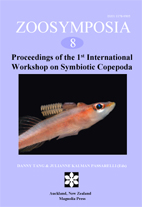Abstract
A new genus and species of copepod, Ttetaloia hoshinoi, of the poecilostomatoid family Chondracanthidae is described based on specimens removed from the body surface of three species of triplefins (Perciformes: Tripterygiidae), Enneapterygius etheostomus (Jordan & Snyder) (type host), E. miyakensis Fricke, and Springerichthys bapturus (Jordan & Snyder), collected in the coastal waters of Izu-Oshima Island and the Izu Peninsula, the North Pacific Ocean, Japan. The new genus resembles Diocus by sharing some important characters in the female, such as a squat trunk bearing well-developed posterolateral processes, a pair of minute caudal rami situated on the midventral surface of the genito-abdomen, and unmodified and biramous legs 1 and 2. The male of the new genus also shares distinct body somites, an atrophied tip on the antenna, and three pairs of legs with the males of Diocus. However, it is clearly differentiated from Diocus by the combination of the following characters: the female has a body comprised of a head and trunk, a head composed of the cephalosome fused with the first and second pedigers and bearing two pairs of cephalothoracic processes on the ventrolateral surface, an unsegmented, asetose antennule, and an accessory process on the terminal uncinate segment of the antenna; and the male has the cephalosome distinctly separated from the first pediger and legs 1 to 3 are all highly vestigial, with the first two pairs consisting of setose knobs and the third pair represented by a minute conical process.

